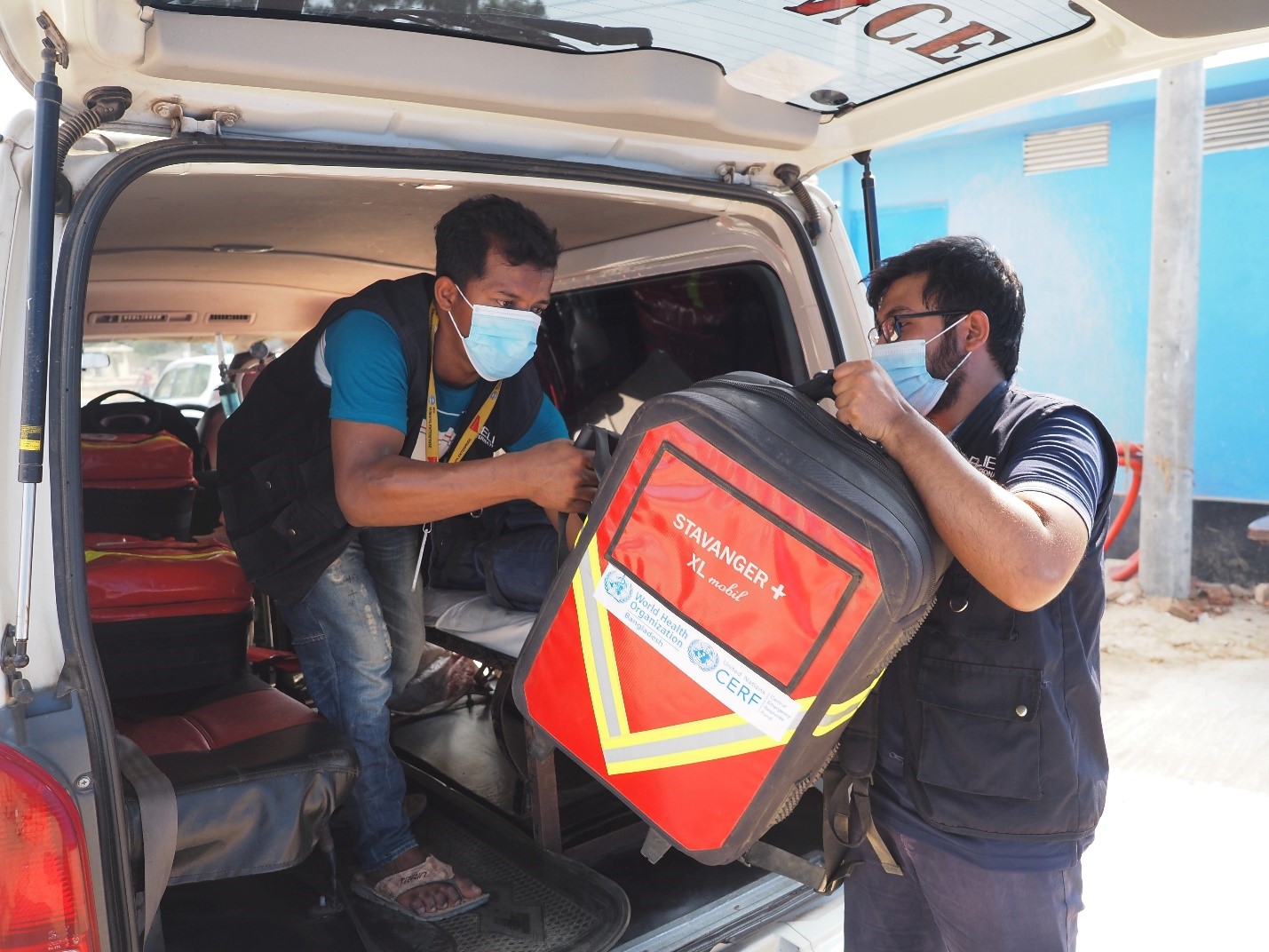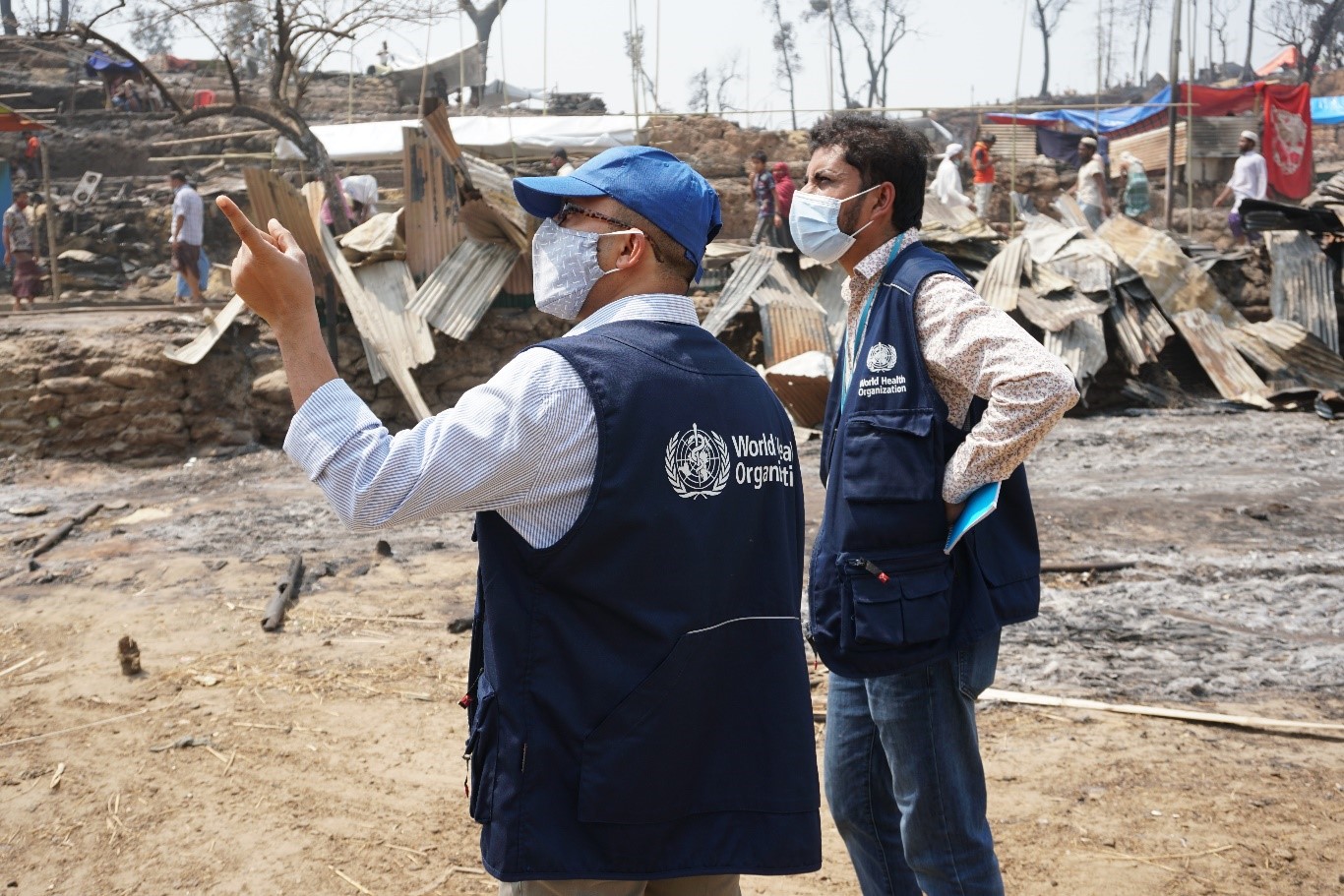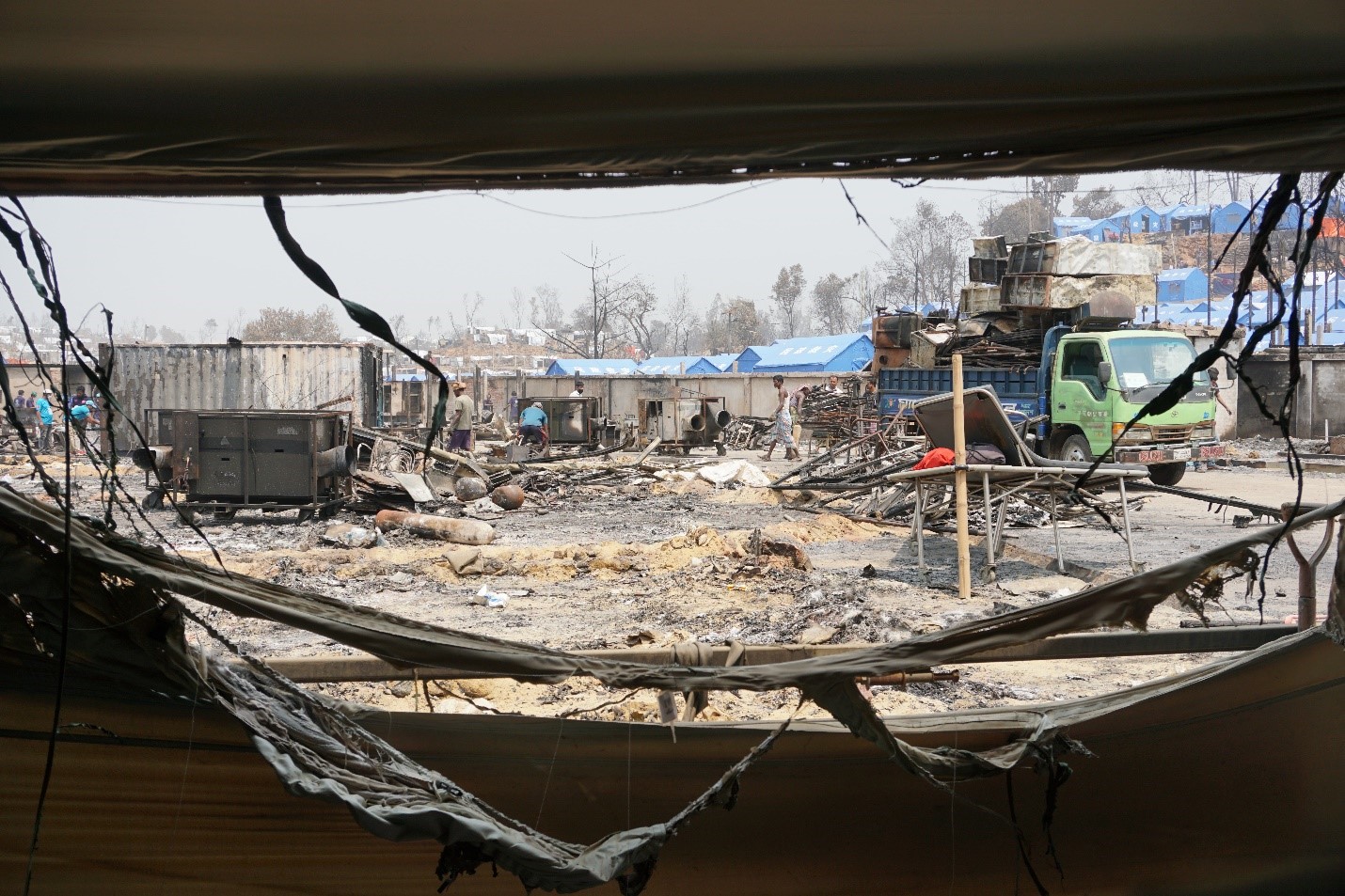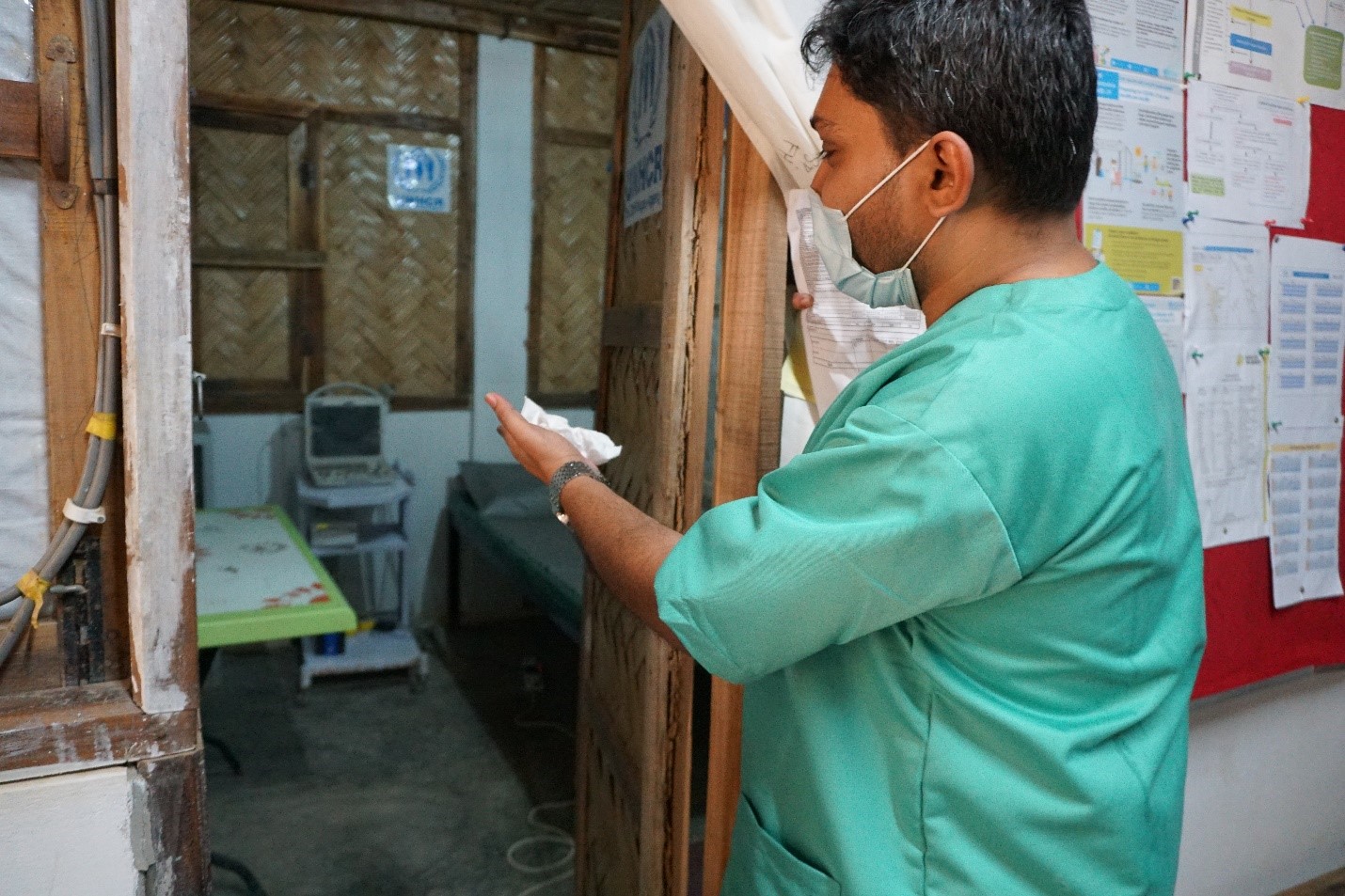On 22 March afternoon the World Health Organization and Emergency Response Teams responded to the massive fire that broke out across three camps in the world’s largest refugee settlement, in Cox’s Bazar, making 45 000 Rohingya refugees homeless overnight.
Resulting in several injuries, hundreds unaccounted for and eleven deaths, this is the biggest fire incident in the Rohingya camps in nearly four years of humanitarian response. At least 10 000 shelters and six health facilities have been reported damaged or destroyed further increasing the vulnerability of the Rohingya people.
“My shelter was destroyed”, tells Md Idriz - a Rohingya religious leader - at an improvised facility in a camp area devastated by the fire. “I have this pain on my chest that makes breathing very difficult. I would also like to know when water and food will be delivered at camp 8”, he adds.
 WHO and partners estimate that 45 000 Rohingya refugees were impacted by the fire that broke out in the Cox’s Bazar refugee camp on 22 March. WHO Bangladesh
WHO and partners estimate that 45 000 Rohingya refugees were impacted by the fire that broke out in the Cox’s Bazar refugee camp on 22 March. WHO Bangladesh
 Around 10 000 shelters were damaged or destroyed leaving this already vulnerable population in greater distress and in need of humanitarian relief. WHO Bangladesh
Around 10 000 shelters were damaged or destroyed leaving this already vulnerable population in greater distress and in need of humanitarian relief. WHO Bangladesh
Mobile Medical Teams (MMTs) from Health Sector Partners were dispatched to respond to the emergency coordinated through the Health Sector Mobile Medical Team (MMT) working group, as part of the WHO and IOM co-chaired Emergency Preparedness and Response Technical Committee.
 When called to respond, the Mobile Medical Team (MMT) from Relief International used WHO trauma bags and kits, including first aid and surgical items to treat 22 Rohingya patients with burns. WHO Bangladesh
When called to respond, the Mobile Medical Team (MMT) from Relief International used WHO trauma bags and kits, including first aid and surgical items to treat 22 Rohingya patients with burns. WHO Bangladesh
Primary health workers that have been trained by WHO through the WHO Mental Health Gap Action Programme (mhGAP) provided mental health services to the patients who attended primary health facilities. Psychosocial support was deployed to communities under the coordination of the Health Sector MHPSS Working Group.
Health Sector response coordination was rapidly established by WHO based on the Health Sector Emergency Preparedness and Response Plan. In the early hours of the fire incident, WHO conducted a rapid assessment on site and delivered medical supplies in support of facilities providing health services to patients presenting with burns and injuries.
 In the early hours of the incident WHO conducted a rapid assessment on site to document the impact of the fire on health services and help guiding the Health Sector’s response while Mobile Medical Teams were already activated and deployed. WHO Bangladesh
In the early hours of the incident WHO conducted a rapid assessment on site to document the impact of the fire on health services and help guiding the Health Sector’s response while Mobile Medical Teams were already activated and deployed. WHO Bangladesh
“Fire response and mobile medical teams were prompted to the camps in the early moments of the incident following the magnitude of the fire ravaging that had not been witnessed before. Partners providing health services in non-affected health facilities near the camps impacted by the fire have reinforced staffing capacity in case of additional patient load for unrelated issues.”, reports WHO Public Health Consultant, Dr Simon Kaddu Ssentamu.
On 22 March afternoon, around 3pm, the fire was still far from the Turkish Field Hospital, located at camp 9. The hospital’s staff did not have reasons to believe that the secondary health facility was at risk.
“I was home when the guards called to inform that the fire had reached our facility. We only had time to transport our patients to safety, everything else was lost in the fire”, recalls Chief Physician of the Turkish Field Hospital, Dr Enes Gidirislioglu.
 An important secondary health facility in the Rohingya refugee camps which is also housing a WHO container for emergency preparedness and response stockpiling, the Turkish Field Hospital was down to ashes within minutes. WHO Bangladesh
An important secondary health facility in the Rohingya refugee camps which is also housing a WHO container for emergency preparedness and response stockpiling, the Turkish Field Hospital was down to ashes within minutes. WHO Bangladesh
“Health facility data collected from 55 nearby health facilities and mobile medical teams confirms they have treated or referred a significant number of patients due to the fire. Fortunately, the vast majority are mild injuries, including superficial burns. A few severe cases have been referred to and managed at the 250 Bed District Sadar Hospital, in Cox’s Bazar, which has Intense Care Unit (ICU) capacity, and to sub-district facilities”, informs Health Sector Coordinator in Cox’s Bazar, Dr Egmond Evers.
“Our health facility was not affected but we did register an increased number of patients immediately after the fire. In the first hours we treated nine patients with different degrees of burn injuries. Among these, one female had to be referred to the Sadar Hospital as her body presented third degree burns. She was also in shock after being trapped in her shelter”, tells Dr Faruk Hassan Safi, Medical Doctor at Food for the Hungry/ Medical Team International (FH/MTI).
 At the Food for the Hungry/ Medical Team International (FH/MTI), in camp 12, Dr Faruk Hassan Safi and his team are securing essential health services’ delivery after six facilities were impacted by the fire. WHO Bangladesh
At the Food for the Hungry/ Medical Team International (FH/MTI), in camp 12, Dr Faruk Hassan Safi and his team are securing essential health services’ delivery after six facilities were impacted by the fire. WHO Bangladesh
In support of partners providing health services in the non-affected camps, WHO immediately dispatched 10 Interagency Emergency Health Kits (IEHK) and three Trauma and Emergency Surgery Kits (TESK) with drugs and disinfectants. Distribution of additional 14 IEHK with medicines,12 IEHK with supplementary medicines, 23 TESK with sutures, injection and dressing materials and 18 Emergency Reproductive Health (ERH) Kits were provided within the first 48 hours.
 WHO Health Sector and Operations Logistics and Support teams delivering life-saving kits at the Food for the Hungry/ Medical Team International (FHMTI) PHC. WHO Bangladesh
WHO Health Sector and Operations Logistics and Support teams delivering life-saving kits at the Food for the Hungry/ Medical Team International (FHMTI) PHC. WHO Bangladesh
 Cox’s Bazar Civil Surgeon, Dr Md. Mahbubur Rahman, with WHO Health Sector Field Coordinator, Sayed Sobuj, talking with Rohingya refugees affected by the fire. WHO Bangladesh
Cox’s Bazar Civil Surgeon, Dr Md. Mahbubur Rahman, with WHO Health Sector Field Coordinator, Sayed Sobuj, talking with Rohingya refugees affected by the fire. WHO Bangladesh
“Bangladesh is deeply touched by the fire incident that has affected the Rohingya camps this week. The priority now is to support the reestablishment of primary health care capacity to cover for the health facilities that have been impacted to serve the families returning as shelters are being rebuilt”, says Cox’s Bazar Civil Surgeon, Dr Md. Mahbubur Rahman, during his visit to sites of damaged health facilities.
“WHO is working closely with the Government of Bangladesh to support the Rohingya people following the fire incident and its tragic impact among this vulnerable community. We have been working very hard over the past months to strengthen the capability of the healthcare system in Cox’s Bazar to manage burn injured patients which helped to mount an appropriate health response to this incident and improve patient outcomes. This work will continue to ensure sufficient capacity and capability to respond to similar incidents in the future given the particularly fragile context”, notes WHO Head of Sub-Office, Dr Kai von Harbou.
To enhance capacity of fire emergency response in Cox’s Bazar, in February WHO organized two webinars on fire safety for health facilities and management of patients with burns and related injuries in collaboration with IOM and engineers of ARUP (UK). A webinar on management of burns was also organized by WHO with the expert support from the Australian Medical Assistance Teams (AUSMAT) early this year. The two trainings combined reached 125 health managers and 85 clinical staff.
Only three days after the fire, WHO and the Health Sector conducted a refresher webinar on “Emergency Burn Mass Casualty Incident (MCI) First Aid care for Mobile Medical Teams”. Further in-person trainings are planned for the coming days to enhance fire safety on health care facilities in collaboration with Civil Surgeon Office, the Refugee Relief & Repatriation Commissioner (RRRC), Civil Defense Authority, Cox’s Bazar Medical College and International Committee of the Red Cross (ICRC).
